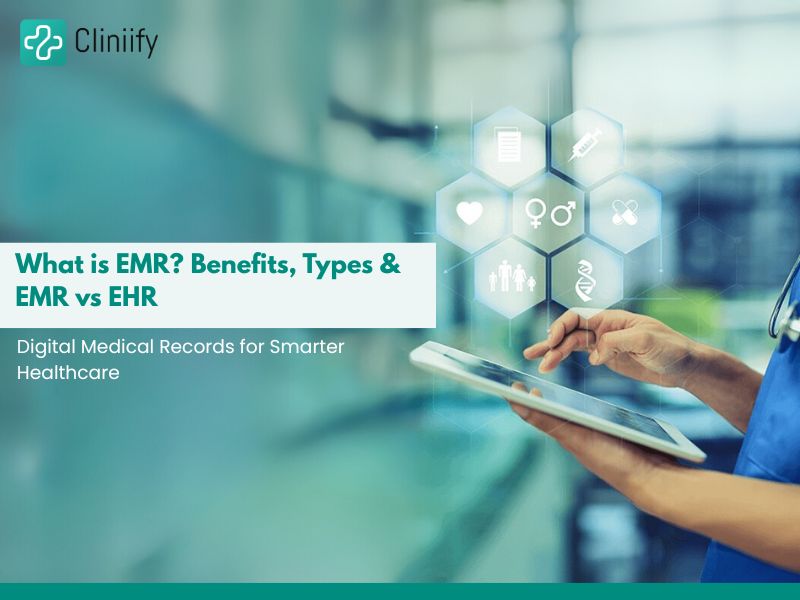
What is EMR? Benefits, Types & EMR vs EHR Explained for Indian Healthcare
Managing patient records manually can slow down your clinic and increase errors. Electronic Medical Records (EMRs) streamline healthcare operations, making patient data secure, accessible, and organized. Clinics and hospitals can enhance workflow efficiency, reduce errors, and improve patient care outcomes. Understanding EMR, its benefits, types, and how it differs from Electronic Health Records (EHRs) helps you select the right solution for your practice.
With Cliniify EMR, a cloud-based, fully interoperable platform, patient record management becomes faster, safer, and smarter—so your clinic can focus on what matters most: delivering exceptional patient care.
What is EMR?
An Electronic Medical Record (EMR) is a digital version of a patient’s paper chart used within a single healthcare facility.
EMRs store vital information such as:
- Medical history, diagnoses, and treatment plans
- Prescriptions and lab results
- Imaging and procedural data
Unlike paper charts, EMRs provide:
- Instant access to patient information
- Improved accuracy and efficiency
- Seamless internal communication among clinicians and staff
Key Features of Cliniify EMR :
- Comprehensive Patient History – Track diagnoses, medications, and procedures in one place.
- Digital Prescriptions – Reduce errors and improve compliance.
- Workflow Management – Streamline appointments, follow-ups, and lab reporting.
Cliniify EMR ensures clinics and hospitals manage records efficiently while maintaining compliance with healthcare regulations.
Benefits of EMR
EMRs deliver advantages for both healthcare providers and patients
- 1. Streamlined Data Management
- Organize patient information across departments, improving workflow efficiency and supporting informed clinical decisions.
- 2. Enhanced Physician Awareness
- Doctors get real-time updates on patient history, medications, and ongoing treatments, enabling coordinated care and minimizing errors.
- 3. Operational Cost Reduction
- Digital records reduce paperwork, printing, and storage costs. Automated reminders and reporting save time and resources.
- 4. Scalable Technology
- Cloud-based EMRs like Cliniify scale easily to accommodate additional users, locations, and features without significant investment.
- 1. Improved Access to Care
- Centralized records allow doctors to provide faster, informed, and consistent treatment.
- 2. Data Security and Privacy
- Advanced security protocols ensure sensitive patient information is protected and accessible only to authorized personnel.
- 3. Easy Report Tracking
- Diagnostic results, prescriptions, and treatment records are stored digitally for quick access by both patients and providers.
- 4. Supports Preventive Care
- Accessible health data helps patients monitor progress and follow treatment plans, enabling proactive healthcare.
For Healthcare Providers
For Patients
- 1. Single-Provider EMRs
- Ideal for individual clinics or small practices
- Simple installation and localized data management
- Basic reporting and analytics
- 2. Multi-Provider / System-Based EMRs
- Cloud-based or server-based solutions
- Access across multiple locations
- Integration with labs, pharmacies, and imaging systems
Types of EMRs
Choosing the right EMR depends on your clinic’s size and workflow requirements:
Cliniify EMR is a cloud-based, interoperable platform suitable for clinics and hospitals of any size, providing centralized access across multiple locations.
EMR vs EHR: Key Differences
While often used interchangeably, EMRs and EHRs serve different purposes:
| Feature | EMR | EHR |
|---|---|---|
| Scope | Data confined to a single clinic or hospital | Comprehensive patient health record shared across multiple providers |
| Purpose |
Diagnosis and treatment within one facility |
Coordination of care among specialists, labs, and hospitals |
| Interoperability | Limited; internal use | High; designed for cross-institution data sharing |
| Use Case | Small to medium clinics or single-hospital setups | Large hospitals, multispecialty centers, or integrated healthcare networks |
| Cost | Lower implementation costs | Higher due to complex integration requirements |
Conclusion
Electronic Medical Records (EMRs) are transforming healthcare by making patient data digital, accurate, and secure. They reduce errors, enhance care, and streamline clinic operations. Cliniify EMR provides a cloud-based, interoperable, and scalable platform designed to meet the needs of clinics and hospitals of all sizes
Take action today: Upgrade your clinic with Cliniify EMR and embrace the digital future of healthcare.
👉 Ready to upgrade? Book a Free Demo with Cliniify today and experience the future of digital healthcare.